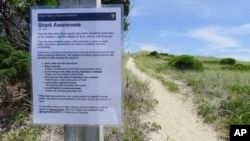U.S. shark researchers caught and tagged 2,835 sharks along the East Coast this spring, a record number which they say reflects a growing population thanks to federal protections.
It surpassed the 1,831 sharks captured and tagged in 2012 during the survey which is conducted every three years by the National Oceanic and Atmospheric Administration (NOAA).
The numbers have increased in each survey since 2001, and point to steady population gains, NOAA spokeswoman Shelley Dawicki said.
The increased shark count comes in the wake of a spate of shark attacks on swimmers this summer off the coast of Florida and the Carolinas, though researchers say the annual trend is about normal.
Sharks were on the decline in 1986 when the first survey took place during a worldwide boom in commercial sharkfin fisheries to feed Asian markets.
U.S. protections for sharks in a fishery management plan went into effect in 1993. The plan banned fishing for certain sharks and limited fishing seasons for others, among other rules.
"I think that's what turned it around - effective management. Just the decrease in fishing pressure on these species has helped quite a bit," said Lisa Natanson, a scientist who leads the survey at the Narragansett Laboratory of NOAA Fisheries' Northeast Fisheries Science Center.
The survey, which takes place in April and May, begins off the coast of Florida where sharks spend the winter and spring and follows their migration route to Delaware as waters warm.
This year and last, bad weather ended the survey in North Carolina.
Since 1996, each survey has been conducted in same manner, including use of the same bait and gear, Natanson said. The researchers note the age, sex, size and location of the sharks they encounter during tagging.
The survey allows researchers to collect data immediately, as well as years later when a tagged shark is inadvertently caught in fishing gear.
The NOAA survey is the longest running coastal shark research survey along the East Coast, but many other shark tagging programs add to research data, Natanson said.
NOAA's Cooperative Shark Tagging Program involves 7,000 volunteer commercial and recreational anglers who tag sharks on the Gulf and Atlantic in North America and Europe.
A tagging and tracking project for mako sharks at the Guy Harvey Research Institute at Nova Southeastern University since 2009 has been following the sharks migratory behavior.







